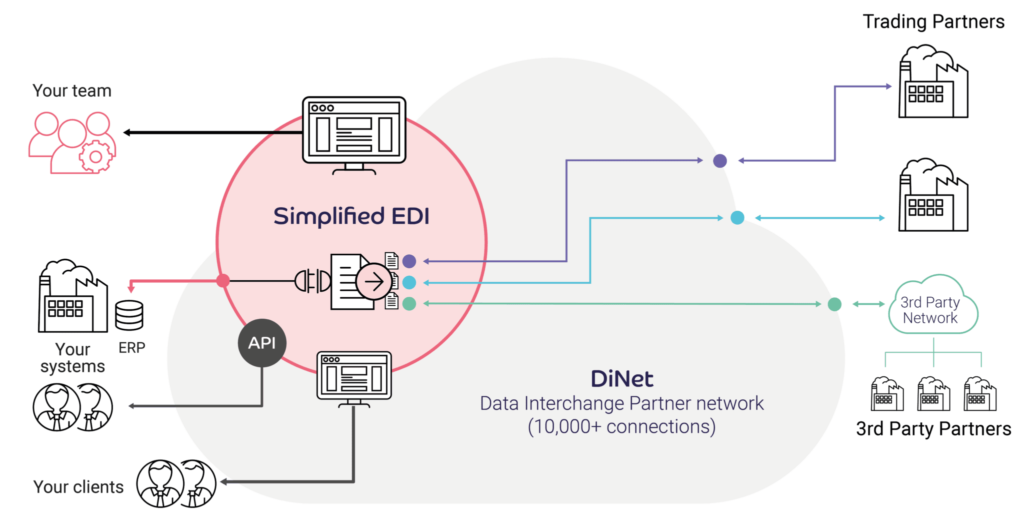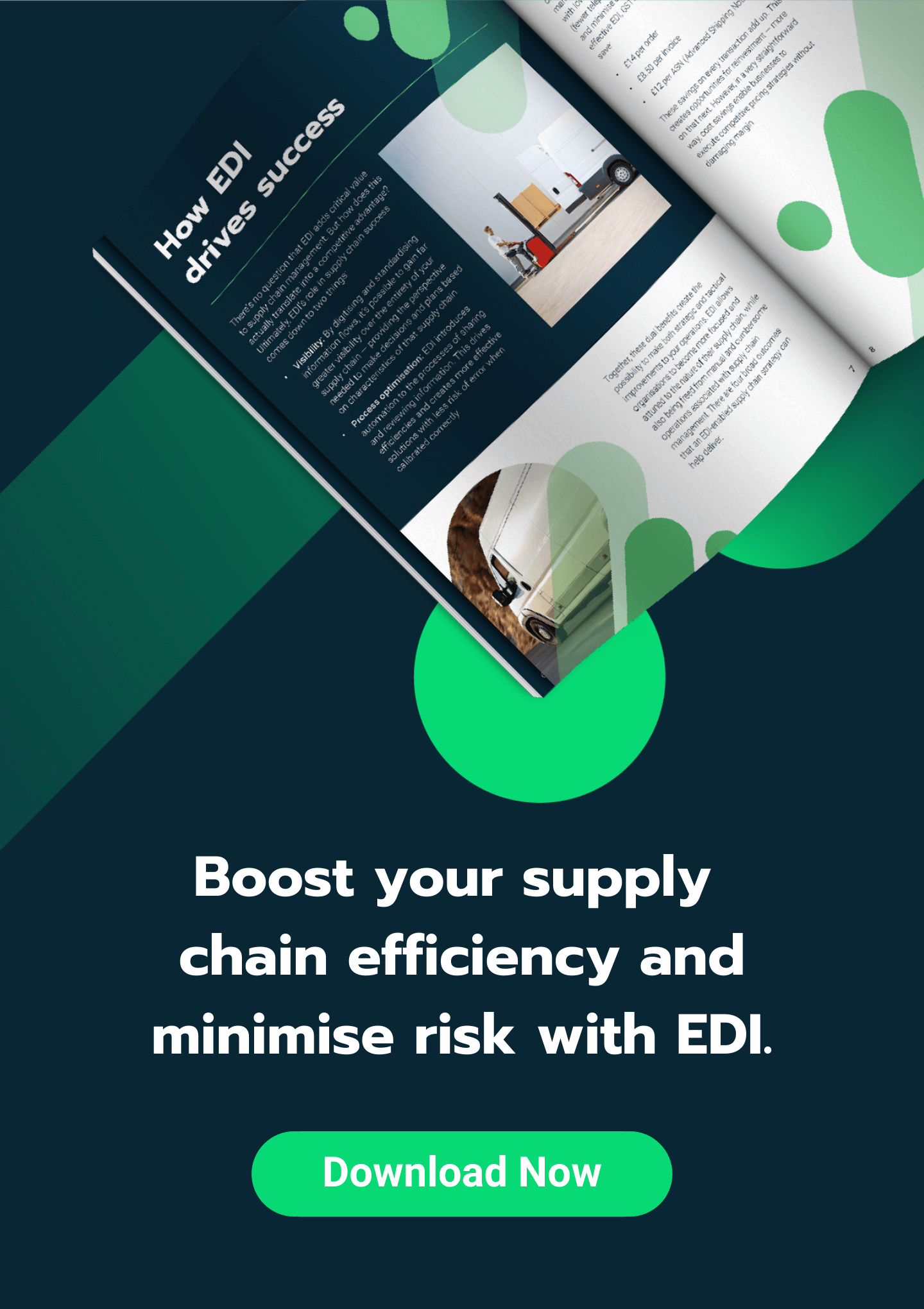EDI vs API: Bridge the B2B connectivity gap
To the every-day user, the complexities of the inner workings of a car are deliberately hidden from them. Despite the thousands of individually manufactured components that are, in turn, assembled into larger units, that are then seamlessly brought together as a single working system, the car remains fully under the control of the driver at all times, with only a few easy to learn controls. Here, the complexities of the vehicle are deliberately obfuscated from the user to provide a simpler and more accessible customer experience, allowing the driver to focus on what’s important – the journey.
How does this relate to types of B2B integration?
Manufacturers have continually sought to simplify the complexities of integrating their complex supply chains, removing the need for unnecessary human interactions, and driving for every efficiency available. A key aspect of this approach has been the continued use of Electronic Data Interchange (EDI), an evolving technology that has been the backbone of sharing electronic business documents between trading partners for many decades, and continues to be an effective method of implementing ever closer integration between both customers and their suppliers.
EDI is a standardised, reliable, and proven method of communicating and sharing important trading information across the supply chain, and is used to underpin billions of pounds worth of transactions globally each year. It is an indispensable technology that delivers reduced operating expenses and improved value chain communications to all sizes and types of businesses around the world. Its founding principle is in reducing the complexity of commercial, and logistics challenges that businesses face every day, to free them up to innovate, build markets, and grow revenue.
Getting business done efficiently
EDI allows businesses to get more done, be more productive, facilitate efficient processes, and eradicate the risk of manual errors, by automating business-to-business (B2B) communications. For firms in the automotive, manufacturing, logistics, healthcare, and supply chain sectors, EDI has become a critical tool organisations that manufacture, assemble, transport, buy, and sell goods around the world.
There are significant benefits to the use of EDI as a mechanism of supporting commercial processes between customers and their suppliers:
- EDI can be quick to implement due to known published EDI standards such as EDIFACT, VDA, ANSI, and TRADACOMS
- There’s a large and well-established ecosystem of technology providers specialising in the implementation and adoption of EDI services
- The large variability of software applications in both age and complexity means EDI technologies can easily be used to transform files into different formats and structures to support even legacy systems
- Exchanging business documents electronically, computer-to-computer significantly improves the overall speed of communications allowing more reliable “Just In Time” exchanges to be realised with greater accuracy
- With human involvement in the process significantly reduced, errors caused through the manual re-keying of data are dramatically reduced
- Without the double-handling of business data that sits at the heart of manual processes, increased efficiencies can be seen, with key staff redeployed onto other more strategic activities
- Closer ties with trusted trading partners will improve relationships and can herald new business opportunities through closer collaboration
EDI challenges
However, EDI can also pose some challenges for IT teams looking for a strategic enabler of supply chain integration and optimisation. Despite the vast business benefits EDI can deliver, many companies have found that it can be labour intensive to maintain up-to-date compliance with trading partner requirements. In addition, the ability to train and retain suitably qualified technical resources, as well as the purchasing and maintaining of EDI software can also pose further problems.
- EDI experience and appropriate skills are not readily available within the wider integration market space in comparison to other integration approaches, such as APIs, which are routinely understood
- EDI can be complex to initially set up and may require additional technology, or an ongoing relationship with EDI specialist service providers
- Different companies tend to use EDI standards in different ways meaning there’s still significant variabilities to support seamless trading between different customers and suppliers
- Due to its longevity, EDI is seen as yesterday’s technology, despite having a strong track record in enabling B2B integration over many decades
As a result, many companies are exploring other more accessible technologies as an alternative to EDI. Alternatives that can simplify the adoption of EDI and provide a more open framework from which integration is more readily aligned with existing skills commonly available within a business.
Can EDI be replaced by APIs?
In Gartner’s recent report – “Use APIs to Modernize EDI for B2B Ecosystem Integration (June 2019)”– the strategic assumption for B2B integration planning purposes was stated as:
“By 2023, over 50% of B2B transactions will be performed through real-time APIs versus traditional approaches.”
APIs, therefore, are seen as the growth-enabler for closer integration with trading partners and a mechanism by which information can be shared in real-time, opening up additional integration scenarios. Forward-thinking manufacturers continue to invest in Industrial Internet of Things (IIoT) technologies and continue to explore the use of APIs to extend data sharing, both internally and externally.
APIs are often considered to be more applicable in application-to-application oriented integration scenarios and have some initial benefits over the use of EDI, including:
- APIs are considered a more modern integration method than EDI, despite EDI having a proven track record in enabling B2B supply chain integration
- As almost a complete opposite to EDI, API skills are readily accessible within IT circles with almost all IT graduates having the skills to understand and exploit available APIs
- APIs are typically easy to understand leading to a much faster time to implement and gain value
- Real-time integration using APIs ensures that systems can be updated immediately, whereas individual EDI transactions are often scheduled for specific times or batched up together
- APIs can be scaled to millions of transactions with little increase in complexity
API drawbacks
But it’s not all plain sailing, however. Like many technology solutions, APIs also have some drawbacks in comparison to EDI:
- With little in the way of standards, APIs vary in structure so it can be difficult to manage the variability of structures and capabilities for different APIs
- Older, legacy applications are rarely compatible with newer API technologies meaning it can be difficult or impossible to use APIs
- APIs can require more maintenance in the long term in order to deal with new versions and data structures
- As a more modern integration technique, APIs are not in widespread use for B2B integration in comparison to EDI
- Security concerns are paramount for the use of APIs, with vulnerabilities being able to be exploited without additional technology to protect the application
With no clear winner, either way, a hybrid EDI/API solution would appear to be the favoured way in which to harness the proven capabilities of EDI while enjoying the accessibility of API technologies. A solution in which some of the complexities of EDI could be simplified using a more modern approach to integration. A solution where the variations of EDI standards and protocols could be reduced to only a single defined set of APIs that could be used to send and receive files between customers and their trusted suppliers?
Introducing DiNet Partner Edition
DiNet Partner Edition, from Data Interchange, embraces both EDI and APIs within a single EDI-as-a-Service cloud platform, enabling greater flexibility in B2B integration scenarios, for technology service providers, managed service organisations, direct manufacturers, and their extended supply chains.
DiNet Partner Edition is a scalable, self-service cloud-based EDI platform, built to support partner integration initiatives. It is a comprehensive EDI integration platform delivering complex connectivity, translation, and data conversion with the simplicity of an API, allowing direct EDI connections but leveraging Data Interchange’s connected trading partners, VAN inter-connects, and other monitored connections.
As part of Data Interchange’s scalable DiNet platform, DiNet Partner Edition features native support for direct connections using common EDI protocols such as FTP, SFTP, OFTP/2, AS2, or sending via DiNet’s extended trading network of shared connections to the world’s largest manufacturers and suppliers. DiNet Partner Edition provides additional connectivity options to common EDI functions via a modern, easy-to-learn API, including allowing partners to submit files for processing, as well as get updates on file transmission details.
With its sophisticated support for standard and custom file formats, customisable workflows, and flexible file routing, DiNet Partner Edition is capable of processing millions of variations of files, transforming them from one format to another, and doing so in an efficient, secure, and scalable manner. With its flexible error handling and alerting you’ll always be one step ahead of any file processing issues or failed connections.
DiNet Partner Edition also comes with comprehensive visibility over each and every file interaction with a full audit trail maintained for each, including low-level details of session information relating to the receipt and transmission of each file. With all configuration changes fully audited and restricted via detailed security controls, DiNet Partner Edition is a secure platform for delivering modern EDI services to your customers.
What’s more, customers themselves are able to monitor the progress of their files using an easy-to-use web portal, providing 24*7 access from a range of devices and from any location.
DiNet Partner Edition also comes with comprehensive visibility over each and every file interaction with a full audit trail maintained for each, including low-level details of session information relating to the receipt and transmission of each file. With all configuration changes fully audited and restricted via detailed security controls, DiNet Partner Edition is a secure platform for delivering modern EDI services to your customers.
What’s more, customers themselves are able to monitor the progress of their files using an easy-to-use web portal, providing 24/7 access from a range of devices and from any location.

A fully integrated cloud-EDI solution
DiNet Partner Edition’s fully integrated cloud EDI solution supports partners looking to increase customer value through the delivery of seamless EDI integration services, with immediate access to Data Interchange’s B2B expertise and extended trading partner network.
- Modernise your EDI – benefit from a comprehensive EDI platform that embraces modern API standards providing a choice of integration options
- Save time – get a single connection to all your trading partners, reducing the need to create and manage individual connections
- Reduce costs – a managed service means no expensive in-house programmes or resources are needed to reap the rewards of EDI
- Reach beyond your network – manage your direct EDI connections while leveraging Data Interchange’s extended network of over 10,000 connected trading partners, inter-connects, and monitored connections
- See everything – with flexible reporting, instant alerts, workflows, and visibility dashboards
- Data transformation – send and receive messages in different formats to suit each of your trading partners’ requirements
Data Interchange has a demonstrable track record providing a wealth of flexible EDI services to direct customers and other global organisations. For over 30 years, Data Interchange has delivered specialist EDI services to large OEMs, tier 1 and 2 manufacturers, retailers and healthcare organisations.
Summary
So just like the complexities of a moving vehicle can be reduced to just a few simple controls operated by the driver, so too can the complexities and variabilities of EDI be hidden and reduced to a few, easy to learn APIs, increasing both the speed of adoption and widening the approaches that complex supply chains can leverage to become ever more closely integrated.
Whatever your approach to B2B integration, Data Interchange are combining the proven resilience, flexibility and maturity of EDI, with the modernity, speed and agility of APIs, in a single flexible cloud-based B2B integration platform. Combining the speed of execution and resilience that EDI provides, with the additional benefits of APIs, enables greater options for supply chain integration, ensuring companies are easier and more attractive to do business with, while reducing the overheads involved in working in complex and competitive environments.
Trust in DiNet Partner Edition to remove EDI complexity.































































































































